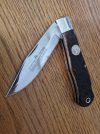- Joined
- Oct 17, 2020
- Messages
- 36
Hi folks,
About a year ago I came here out of frustration with my inability to get any knife sharp. You all helped me immensely. I picked up a Buck Honemaster for angle control, DMT blue coarse stone, and the Bark River black and green compounds. With just three steps (DMT blue > BR black > BR green) I've gotten every knife in my collection sharp enough to comfortably shave with.
I met my match last night, on a Queen Mountain Man with D2 blade. First off, the sabre grind on it is much more obtuse than the 30° inclusive angle the Honemaster provides, so it took hours to reprofile the edge and get full burrs. I probably should have tried a larger angle that didn't involve removing so much metal, or at least a coarser stone that would have done it faster. But I stubbornly used what I have. In my impatience, I got careless and ground off the very tip of the blade, as well as put a lot of needless scratches into the mirrored finish. Frustrating, but it will be used so not the end of the world.
Next came removing the burr, which I do using light leading edge passes on the DMT blue. This took many more sweeps than normal, and I really wasn't sure if the burr was fully gone. It felt like I was in danger of dulling the edge, so I moved on to the strops. Long story short, the Bark River compounds did not touch this steel. So now I have a weird looking polished blade with a rough 300 grit bevel that is not sharp to my liking. It will very roughly shave but that's about it. Furthermore, the curved part of the blade is noticeably duller than the rest, which makes no sense because I am definitely getting full-length burrs (Ive tried twice now). No idea what's going on there--I guess I must be grinding my edge when I lift the knife while trying to remove the burr...
Anyway, what would be the most cost effective way to further hone this D2 edge? I've heard of diamond stropping compounds, should I just try that in place of the Bark River stuff? Suggestions on products? I plan to get some modern knives with harder steels in the future so this might apply to more than just D2. All thoughts appreciated.
About a year ago I came here out of frustration with my inability to get any knife sharp. You all helped me immensely. I picked up a Buck Honemaster for angle control, DMT blue coarse stone, and the Bark River black and green compounds. With just three steps (DMT blue > BR black > BR green) I've gotten every knife in my collection sharp enough to comfortably shave with.
I met my match last night, on a Queen Mountain Man with D2 blade. First off, the sabre grind on it is much more obtuse than the 30° inclusive angle the Honemaster provides, so it took hours to reprofile the edge and get full burrs. I probably should have tried a larger angle that didn't involve removing so much metal, or at least a coarser stone that would have done it faster. But I stubbornly used what I have. In my impatience, I got careless and ground off the very tip of the blade, as well as put a lot of needless scratches into the mirrored finish. Frustrating, but it will be used so not the end of the world.
Next came removing the burr, which I do using light leading edge passes on the DMT blue. This took many more sweeps than normal, and I really wasn't sure if the burr was fully gone. It felt like I was in danger of dulling the edge, so I moved on to the strops. Long story short, the Bark River compounds did not touch this steel. So now I have a weird looking polished blade with a rough 300 grit bevel that is not sharp to my liking. It will very roughly shave but that's about it. Furthermore, the curved part of the blade is noticeably duller than the rest, which makes no sense because I am definitely getting full-length burrs (Ive tried twice now). No idea what's going on there--I guess I must be grinding my edge when I lift the knife while trying to remove the burr...
Anyway, what would be the most cost effective way to further hone this D2 edge? I've heard of diamond stropping compounds, should I just try that in place of the Bark River stuff? Suggestions on products? I plan to get some modern knives with harder steels in the future so this might apply to more than just D2. All thoughts appreciated.

